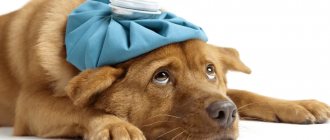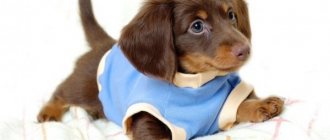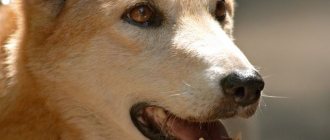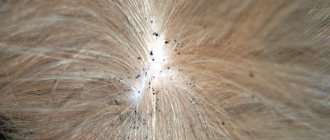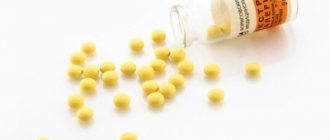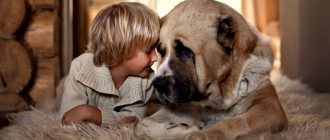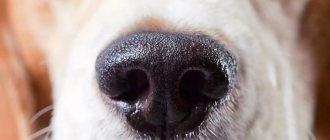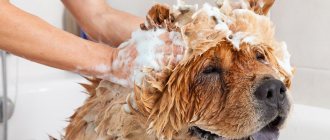- about the author
- VK profile
Svetlana Tarasova
Hairdresser-stylist with more than 8 years of experience, expert in the field of haircuts, styling, hair care, coloring.
Everyone knows about such a disease as pediculosis in humans. But it turns out that lice can also infect dogs! This problem should not cause much concern for owners of four-legged animals, since it can be eliminated without any problems.
Do dogs have lice and nits, what do they look like and can they live long?
Dogs, like many other animals, can carry lice and nits. They can be identified by careful examination of the animal's fur.
Nits look like small white grains attached to the fur, most often located closer to the root part. In appearance they resemble dandruff. The life cycle of a nit lasts 21 days.
Lice are usually small, yellow-gray in color, have a narrow, flattened, elongated body and an elongated head. Visually, you can see a clear division into a narrow head, chest and abdomen. There are no eyes, the mouthparts are of the piercing-sucking type, and there are claws on the paws. Parasites are most often localized on the tips of the ears, near the eyes, around the anus and in places where the fur gets tangled.
Without a host, lice live no more than 3 days. The process of treatment and complete recovery takes up to 30 days.
Diagnosis of pediculosis
The above symptoms are a reason to take your dog to the vet. Ectoparasites can be detected visually by carefully examining the pet’s fur and skin. Dog lice love moisture - they can be found in the area of the animal's anus and in places where there is damage to the skin: scratches, scratches.
In a veterinary clinic, the found samples of parasites and their eggs are examined under a microscope. In addition, the veterinarian conducts a microscopic examination of the animal's hair and skin scrapings. The final diagnosis is made based on a comparison of clinical symptoms and visual identification of lice and nits.
Types of lice in dogs, the difference between lice and fleas, why lice are dangerous for an animal
There are two types of lice found in nature that infect dogs:
- Trichodectes canis (lice eaters) – chewing or biting lice. They are distinguished by a flat, blunt head. They feed on epidermal cells and sebaceous secretions of the skin. They are carriers of tapeworms. They feed on dog fluff and skin scales.
- Linognathus setosus - sucking lice. They are more common in regions with cold climates. Affects long-haired dogs. Characterized by a pointed proboscis. They feed on the blood and lymph of dogs.
The flea's body has a laterally compressed shape, covered with scales, bristles and spines. The flea can reach 5mm in length, and sometimes more.
Important! To distinguish a flea from a louse, look at their mode of movement. Lice run very quickly, and fleas move by jumping.
Lack of adequate treatment for parasites threatens the dog with depression of the nervous system, exhaustion, anemia, and infection with helminths . Also, lice can provoke the appearance of purulent wounds and skin diseases (dermatitis, eczema, etc.)
How to tell if it's lice or fleas
The main difference between fleas and lice is the ability to jump. The flea quickly moves around the body in short jumps, which is visible to the naked eye. Lice are smaller, shorter, and have short, tenacious legs. If you look closely, you will notice that the flea is flat, and the louse is round. In addition, the difference is body color. Lice are predominantly gray or reddish-brown, while fleas are dark, almost black.
Ectoparasite eggs also differ. In fleas they are small, black, similar to sand, and easily flake off the fur. Lice lay round, light-colored nits that adhere firmly to the hair.
Another characteristic feature is the development cycle . Lice lay fewer eggs, but their larvae do not go through the pupal stage, and seven days after emergence they begin to drink blood. Fleas mature for about a month; during this period they do not feed on blood.
Symptoms of lice and nits in dogs, causes and routes of infection
To detect lice on a dog, it is enough to examine the pet. Adults can be seen with the naked eye, and when combing the fur, white nits will stick to the hairs, unlike dandruff.
Reference! If you wet the skin of a lice-infested dog, you can smell the mice.
Symptoms of linognathosis disease:
- Constant itching.
- The animal bites insects.
- The coat loses its shine, has an unkempt appearance, becomes matted, and may fall out.
- Skin disorders, dermatitis, dryness, redness.
- Bald spots appear.
- The dog is losing weight.
- Sores and suppuration appear at the bite sites.
- Developmental delay in puppies.
- Sleep disturbance, depression.
- Anemia – when severely affected by parasites, most often occurs in small breeds of dogs and puppies.
Important! Skin rashes can be caused not only by lice infestation, but also by other reasons.
Lice infection can only be caused by contact with a sick animal. But it is worth remembering that a weakened, elderly or young body is more likely to get sick.
Routes of infection:
- From a sick dog to a healthy one.
- From infected mother to puppies.
- While hunting some animals (wolf, arctic fox).
- When living together in kennels, shelters, dog hotels.
- In case of severe infestation, infection is possible through common care items: beds, bedding, combs, upholstered furniture, carpeting.
- Through poorly processed grooming tools.
- Sometimes infection occurs through the shoes and clothing of a person who has been in contact with an infected dog.
Important! Most often, lice disease progresses during the cold season.
Methods of infection
Any breed of dog can become infected with head lice.
The most common routes of infection are:
- Close contact with a sick individual. During a walk, dogs interact closely with each other, and a few minutes are enough to transfer insects.
- Through the owner's clothes or shoes. Insects easily crawl from the fur of an infected animal onto human belongings. They are able to exist without food for a long time until the opportunity of contact with a potential food source arises.
- It often happens that a dog becomes infected in special salons for pets. For example, during a haircut, a salon specialist used tools that were not disinfected.
A large number of parasites can live on the body of pets.
The following factors contribute to the faster spread of lice:
- weakened immunity after illness;
- insufficient cosmetic and hygienic care for the pet;
- inappropriate diet;
- chronic diseases;
- old age.
Can lice and nits be transmitted from a person to a dog and can a person become infected from a dog?
Lice are a specific type of parasite. They can be transmitted and live only on the host species and feed only on the host's blood. Therefore, humans cannot become infected with dog lice . A dog louse can get on a person and even bite him, but the parasite will not be able to survive in the new conditions and will die.
Likewise, human louse cannot be transmitted to a dog even through close contact.
Can children get infected in a pool or lake?
Since the types of lice that live on dogs are not able to survive on humans, there is no risk of infection.
In swimming pools, the water is usually chlorinated and no living organisms can live in it.
In fresh reservoirs with stagnant water, parasites can live for some time, but infection does not occur in the water, but from a sick person (we are talking about lice that infect people).
Diseases caused by lice
What's scary for a dog is not the lice themselves, but the diseases they cause. Infestation can lead to the following problems:
- Eczema and dermatitis. They arise as a response to irritating substances contained in the saliva of lice.
- Various types of suppuration. Lice bite the dog, the dog itches, pathogenic and conditionally pathogenic microflora enter the wounds, and inflammation develops. And at this time, the dog itches further, tears and contaminates the inflamed areas even more... Under such conditions, an abscess or even phlegmon can easily develop.
- Lice contribute to the development of severe fungal infections. Ectoparasites have an extremely negative effect on the immune system, as a result of which it cannot effectively resist threats from the external environment.
Lice are common carriers of infectious diseases, including:
- Lice can carry worm eggs on their paws.
- These parasites are carriers of many infectious diseases, especially of bacterial etiology.
- Lice can carry leptospirosis.
Interesting! Contrary to popular belief, lice cannot tolerate blood parasitic diseases, because The life cycle of Babesia, for example, is strictly tailored to the physiology of ixodid ticks.
How to remove lice from dogs - treatment and the most effective ways to combat parasites
To remove lice, insecticides are used. If necessary, therapy is repeated after 10 days, when new mature individuals may appear from the surviving eggs. After treatment, it is recommended to comb the fur with a thick comb to remove nits or trim the animal.
Unlike fleas (which can jump), lice are unable to escape from a dog's treated fur, making them easier to control.
Types of parasite control products:
- Drops – applied to the withers or along the animal’s spine and rubbed in. May cause allergic reactions.
- Insecticidal sprays - you need to treat all the wool, wait for the time indicated in the instructions and rinse thoroughly.
- Shampoo - applied to the entire coat and rinsed off. Used for treatment and prevention, suitable for small breeds of dogs and puppies. For larger dogs, this treatment is more expensive.
- The collar is easy to use, can also be used for prevention, and eliminates many types of parasites. May cause allergies and skin damage at the site of application.
After lice are removed, wounds, redness, and peeling may remain on the animal’s body, which should be treated with antiseptic and wound-healing medications.
Important! At the end of treatment, the animal must be checked for the presence of helminths.
Treatment
The treatment strategy is developing in the following directions:
- extermination of parasites and measures to protect against re-infection;
- symptomatic remedies to eliminate the consequences of invasion.
It is necessary to understand that products intended for large dogs may be toxic for decorative and small dogs. Insecticides used on adult animals are usually toxic to puppies. Therefore, before purchasing a medicine, you should carefully study the instructions for use.
The following means are used to exterminate parasites:
- Aqueous emulsions.
- Insecticidal powder.
- Ready-made aerosols.
Aqueous emulsions
Deltsid and Entomazan S are popular. The drugs are produced in bottles or ampoules and an emulsion is prepared before use. Work with rubber gloves and safety glasses. To prevent poisoning, take activated carbon or another sorbent. Working fluid is rubbed into the dog or treated with an improvised spray bottle.
Try not to get it in your eyes. Problem areas are treated with a finger dipped in the solution. Do not allow the pesticide to be licked off before it dries. For this purpose, the dog is muzzled for half an hour. In order not to inactivate the insecticide, the dog is not bathed 2 days before and 2 days after treatment.
Since the insecticide does not affect the eggs, you must wait 8–10 days until the larvae hatch and repeat the treatment. The working solution is suitable for use throughout the day. The drugs protect the dog from repeated attacks for no more than 2 weeks.
Insecticidal powder
The drug is used in cold weather, when it is undesirable to wet your pet. Powder is applied to the dog and combed against the grain. The following powders are popular:
- Bolfo;
- Insectal;
- Celandine.
The treatment is carried out outside so as not to stain the furnishings in the apartment.
Ready-made aerosols
The following aerosol insecticides are used:
- BlochNet;
- Bolfo;
- Fiprist;
- Frontline.
The application procedure is the same as for aqueous emulsions. However, sprays have significant advantages:
- long shelf life;
- prolonged validity, no need to process twice.
Symptomatic remedies to eliminate the consequences of invasion
The following tasks must be completed:
- relieve itching;
- stop the inflammatory process;
- cure anemia.
- restore skin health and coat beauty;
To relieve itching, use the drugs Stop Itching or Contravance. To stop the inflammatory process, anti-inflammatory wound healing agents Zooderm are used; Levomekol; Ranozol. To eliminate anemia, the injectable drug Hemobalance is most suitable. To restore the health of the skin and the beauty of the coat, for supporters of natural nutrition, the veterinarian will prescribe the multivitamin feed additive Laveta-super or its analogues.
For those who prefer professional nutrition, the following veterinary foods will help solve skin and coat problems:
- Purina DRM;
- Eukanuba Dermatosis FP;
- Hills d/d.
TOP best remedies against linognathosis in dogs
Drops - destroy parasites and prevent further infection. The active substance accumulates on the skin, in the sebaceous glands and thus has a long-term effect, preventing re-infection. Not absorbed into the blood.
| Name | Compound | Description | Price |
| Leopard | Contains fipronil, diflubenzuron, dicarboximide. | It disrupts the transmission of nerve impulses (causes paralysis), impedes egg laying, disrupts molting, and reduces resistance to insecticides. Can be used from 2 months. Not for pregnant women and sick people. Valid for up to 2 months. | 160 – 270 rub. |
| Frontline | Fipronil | Covers the skin, is retained in the hair follicles and sebaceous glands. Used from 2 months. Protects against parasites for up to 1.5 months. | 400 – 900 rub. |
Shampoos are the most convenient way to treat lice, in addition to the antiparasitic effect, they have moisturizing properties, which reduce itching and improve the quality of the coat. Used to treat puppies and decorative breeds of dogs.
| Name | Compound | Description | Price |
| Celandine | Permethrin | In addition to the insecticidal effect, it protects and nourishes the coat. Not for use in puppies or pregnant dogs. | 150 – 200 rub. |
| Leopard | Essential oils of lavender, costus, cloves, pelargonium | Repels parasites. Can be used in puppies. Safe composition. | 150 – 200 rub. |
| Phytoelite | Permethrin, herbal decoctions | Affects the nerve cells of parasites and causes paralysis. Can be used from 2 months. | 100 – 150 rub. |
Sprays - the active ingredients of sprays envelop the parasite, which contributes to its suffocation. They have almost no effect on nits, which requires additional processing. The difficulty of application is that you need to apply it to the entire coat and leave it on for some time.
Avoid contact with eyes, nose, ears. Often causes allergic reactions.
| Name | Compound | Description | Price |
| Frontline | Fipronil | Covers the skin, is retained in the hair follicles and sebaceous glands. Protects against parasites for up to 2 months. | 800 – 1500 rub. |
| Vet's Best | Clove extract and mint oil | Safe, natural. Can be used from 3 months. | 700 – 800 rub. |
Collars are a universal method of getting rid of lice and fleas at the same time. The accessory is impregnated with active substances that repel pests.
| Name | Compound | Description | Price |
| Bayer Kiltix | Flumethrin | It begins to act within a day after putting it on. The effect lasts 7 months. Suitable for puppies from 2 months and pregnant dogs. | 750 – 1200 rub. |
| Hartz UltraGuard Flea & Tick Collar | Tetrachlorvinphos | The effect of the collar begins immediately after putting it on. The active tape heats up, the poison enters the animal’s body and kills insects. Lasts 7 months. Has a reflective strip and is waterproof. | 900 rub. |
| Scalibor | Deltamethrin | Repels and kills insects. The action begins 7 days after the start of use. Suitable for puppies from 2 months and pregnant animals. | 700 – 1200 rub. |
Rules for using funds
In addition to direct treatment of the dog’s skin and fur, a sanitary inspection of the animal’s feeding and resting place should be carried out. To do this, the kennel, beds, and bedding must be thoroughly washed, treated with a solution of pyrethroid drugs, dried and ironed. Place hygiene items in water and boil for at least 10 minutes.
When applying the lice preparation, be sure to use rubber gloves. Before use, read the instructions, paying special attention to the “Contraindications” section. Since all products containing insecticides are flammable, do not smoke while using them. It is advisable to wear a protective mask or respirator on your face. If there are other dogs living in the house, then the sick individual must be isolated until complete recovery.
How to get rid of lice on dogs at home using folk remedies
Kerosene - apply and distribute throughout the fur (try to get it less on the skin), wrap the animal in cellophane, with a towel on top. Leave for 15 – 30 minutes and rinse with shampoo twice.
Avoid contact of the substance with mucous membranes!
In terms of efficiency, it is inferior to modern means.
Important! Before using kerosene, make sure you are not allergic to it.
Laundry soap - wash the wool with soap for the first time, then apply thick soap foam to the entire surface and leave for an hour, rinse with warm water.
This remedy is not effective enough; it is recommended to be used in combination with other means.
Vinegar (9% is used) – make a solution of 100 ml of vinegar and 200 ml of water, moisten a towel and wrap the animal in it (for a better effect, wrap it in cellophane), leave for 30 minutes and comb out with a comb. Wash with shampoo. Avoid contact with eyes and skin! Combinations of vinegar with mustard, egg, tea tree oil, and vegetable oil are possible.
What are the symptoms
It is not difficult to determine the presence of parasites in an animal, since insects, when they land on the skin, immediately begin to feed on the donor’s blood.
The most obvious signs of lice are:
- Continuous itching caused by parasite bites. The dog is constantly itching, damaging the integrity of the skin. The result is bleeding scratches that attract insects. In the absence of timely treatment, the wounds fester, turning into extensive ulcers.
- The wool loses its luster and bunches up into dense clumps, which can only be gotten rid of by cutting them out. From the areas that the dog scratches more often, the hair gradually falls out and bald spots form.
- Itching from bites does not allow the dog to fully rest. The result is a depressed mood and loss of appetite.
The main clinical symptom of lice in a dog is itching.
Taking into account the symptoms and analysis of the vital activity of lice, it is possible to determine the degree of danger of infection with lice. Firstly, the animal’s nervous and immune systems suffer. Secondly, loss of appetite leads to gradual exhaustion and weight loss, which contributes to the development of anemia. Thirdly, parasites are the main carriers of larvae of various types of worms. Fourthly, lice are a strong allergen.
Preventing lice infestation in dogs and how to clean your house to prevent the disease
To avoid infecting your dog with lice, you need to:
- prevent her from interacting with sick animals
- clean clothes and shoes after going outside
- keep the dog clean
- bathe once a month with pediculosis shampoo
- wear an anti-parasitic collar when going outside
- check the coat regularly
- give vitamin complexes in the spring and autumn.
Interesting! To prevent lice from multiplying, you need to lubricate your dog's fur and skin with coconut oil.
If an animal becomes infected, immediately after treatment it is necessary to carry out treatment in the house to eliminate possible parasites:
- vacuum carpets, floors, upholstered furniture;
- wash the floor with the addition of chlorine, vinegar or ammonia;
- Thoroughly clean and wash the animal’s area, replace the bedding;
- treat all dog accessories (combs, bowls, etc.) - scald with boiling water or place in boiling water for 10 minutes. Iron soft items after washing.
Reference! To treat premises and bedding, you can use detergents: Tetrix, Tsifoks, Agran, Executioner, Cucaracha.
Are different species dangerous?
There are several types of lice on dogs. Main varieties:
- lice eaters;
- elk;
- chicken;
- white.
lice eaters
Lice eaters have a flat body that grows no more than 2 mm. They have a pale yellow tint. Outwardly, they may resemble ordinary lice. The main difference is that lice eaters have a quadrangular head shape, which is much larger than the body itself.
Moose
Moose lice feed only on the blood of warm-blooded animals. They are most often found in moose and cattle, but sometimes they can be diagnosed in dogs.
Chicken
The chicken type of such insects is quite rare in dogs. These lice eaters have a flattened body and a chewing jaw.
White
White lice feed only on human blood. If the dog has white grains in its fur, then these are eggs of ordinary dog lice.
FAQ
Expert opinion
Eve
hair stylist
Ask a Question
Can a Yorkie have lice?
The luxurious coat of Yorkshire Terriers is of great interest to lice. They affect the fur and skin and cause a lot of trouble. The dog should be examined regularly so as not to miss the onset of the disease.
How to remove nits from a husky puppy?
Lice and nits can be removed using special means. When choosing a product, you need to take into account the age and weight of the puppy (the instructions for the drug indicate at what age it can be used). For puppies, drops or shampoos are usually chosen.
How to comb out nits from puppies?
Before combing, you need to wash the hair with a solution of vinegar and water (1:1), this procedure will dissolve the sticky layer that allows nits to stick to the hair. After this, take a thick comb (preferably metal, sold in pharmacies) and comb out the nits, not missing a single area of fur on the animal’s body. The process may take more than one day. Shampooing and combing should be repeated after a week.
Can dogs have pubic lice?
There are only two types of lice that affect dogs: the lice lice and the dog lice. Pubic lice have a special structure of their legs, which allows them to cling only to hair with a triangular cross-section.
What it is?
Lice are small yellow-gray parasites. They are easily confused with lice eaters, as they have almost the same appearance. The difference lies in the way they eat. Lice feed only on lymph and blood. Their mouthparts are adapted to pierce skin and suck blood.
The parasite has a narrow body and a long head. Such parasites secrete a sticky secretion, so the infected dog’s fur sticks together and mats form. Such insects cause a lot of trouble for dogs. The animal constantly feels itching and scratches the bite sites, which leads to the formation of scratches through which the infection penetrates.
Unlike fleas, such parasites cannot jump. The louse is easy to crush with your fingers, since it does not have a chitinous shell.
Prevention
To prevent attacks by ectoparasites, flea collars are used. They are divided into chemical, biological, and ultrasonic. Most dog handlers use insecticidal accessories. Chemical collars are toxic to small puppies and weakened dogs. Therefore, if ectoparasites are found on the cubs, they are bathed using repellent shampoos that repel insects. The treatment provides short-term protection from attack until the age at which insecticidal drops are permitted to be used.
Constant coat care is required. The formation of tangles should not be allowed.
Flea collar
Lice that attack a dog cause it suffering, characterized by constant itching and sleep disturbances. Measures to destroy all types of ectoparasites are the same.
We invite you to join our Zen channel and group on VKontakte or Odnoklassniki, where new articles for pet owners are published.
Similar articles:
- What is separation anxiety in dogs and how to deal with it?
- Tuberculosis in dogs
- Umbilical hernia in dogs
Prices for drugs
Approximate cost of products for treating a dog against lice:
- Stronghold in drops - from 1550 to 1650 rubles.
- Frontline in drops - from 515 to 850 rubles.
- Hartz Ultra Guard Plus in drops from 1250 to 1360 rubles.
- BIO-GROOM in the form of shampoo - from 2000 to 2260 rubles.
- Iv san bernard in the form of shampoo - from 380 to 395 rubles.
- Bars (Agrovetzaschita) in the form of shampoo - from 165 to 175 rubles.
- GreenFort Neо (release form - spray) - from 400 to 430 rubles.
- RolfClub 3D in spray form - from 450 to 480 rubles.
- Api-San Dana Ultra - 260 to 280 rubles.
- Green Fort (collar) - 210 to 230 rubles.
- Foresto (Bayer) – collar – from 1500 to 2250 rubles.

